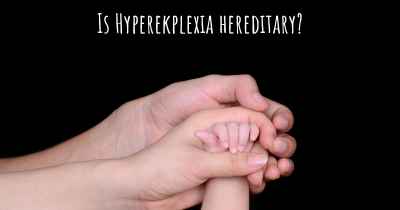What is the history of Hyperekplexia?
When was Hyperekplexia discovered? What is the story of this discovery? Was it coincidence or not?

Hyperekplexia, also known as startle disease or exaggerated startle response, is a rare neurological disorder characterized by an abnormal reaction to sudden, unexpected stimuli. Individuals with hyperekplexia experience an excessive and involuntary startle response, often accompanied by muscle stiffness or rigidity. This condition can significantly impact a person's quality of life and daily functioning.
Historical Background:
The first documented case of hyperekplexia dates back to the late 1950s when Dr. Kok and Dr. Bruyn described a Dutch family with an inherited startle syndrome. They observed that affected individuals exhibited an exaggerated startle response, leading to falls and injuries. This initial discovery laid the foundation for further research into the disorder.
Genetic Discoveries:
In the 1990s, significant progress was made in understanding the genetic basis of hyperekplexia. Researchers identified mutations in the glycine receptor genes (GLRA1, GLRB) as the primary cause of the disorder. These genes encode proteins involved in the inhibitory neurotransmission pathway, which regulates the transmission of signals between nerve cells.
Further studies revealed that mutations in the GLRA1 gene were responsible for the majority of familial cases, while GLRB mutations were more commonly associated with sporadic cases. These genetic discoveries provided crucial insights into the underlying mechanisms of hyperekplexia.
Classification and Subtypes:
Hyperekplexia can be classified into two main subtypes: familial and sporadic. Familial hyperekplexia is inherited in an autosomal dominant manner, meaning that an affected individual has a 50% chance of passing the condition on to their children. Sporadic hyperekplexia, on the other hand, occurs without a family history of the disorder and is often caused by de novo mutations.
Within the familial subtype, two distinct forms of hyperekplexia have been identified based on the genetic mutations involved. Type 1 hyperekplexia is primarily caused by mutations in the GLRA1 gene, while type 2 hyperekplexia is associated with mutations in the GLRB gene. Both types result in similar clinical manifestations, although type 2 hyperekplexia may present with additional symptoms such as intellectual disability.
Clinical Presentation and Diagnosis:
Hyperekplexia typically manifests in infancy, with affected newborns displaying an exaggerated startle response to stimuli such as loud noises or sudden movements. The startle response is characterized by a sudden stiffening of the body, often leading to falls or injuries. In severe cases, the excessive muscle rigidity can cause respiratory and feeding difficulties.
Diagnosing hyperekplexia involves a comprehensive clinical evaluation, including a detailed medical history and physical examination. Genetic testing can confirm the presence of mutations in the glycine receptor genes, aiding in the diagnosis and classification of the disorder.
Treatment and Management:
While there is no cure for hyperekplexia, various treatment strategies can help manage the symptoms and improve the quality of life for affected individuals. Medications such as benzodiazepines, clonazepam, or carbamazepine are commonly prescribed to reduce the frequency and severity of startle episodes.
Additionally, physical therapy and occupational therapy can be beneficial in improving muscle tone, coordination, and overall motor skills. Early intervention and support from a multidisciplinary team are essential in optimizing the developmental outcomes for individuals with hyperekplexia.
Conclusion:
Hyperekplexia is a rare neurological disorder characterized by an exaggerated startle response. Through decades of research, significant progress has been made in understanding the genetic basis and underlying mechanisms of the disorder. Genetic discoveries have identified mutations in the glycine receptor genes as the primary cause of hyperekplexia, leading to improved diagnosis and classification. While there is no cure, various treatment strategies and supportive therapies can help manage the symptoms and enhance the quality of life for individuals living with hyperekplexia.








